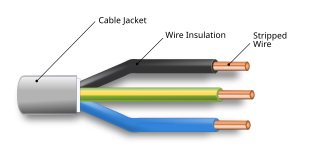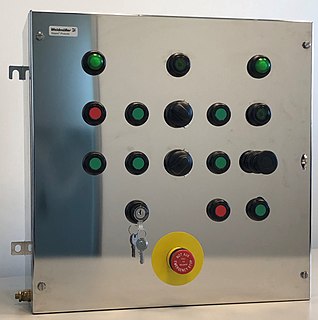Related Research Articles

Metallic bonding is a type of chemical bonding that arises from the electrostatic attractive force between conduction electrons and positively charged metal ions. It may be described as the sharing of free electrons among a structure of positively charged ions (cations). Metallic bonding accounts for many physical properties of metals, such as strength, ductility, thermal and electrical resistivity and conductivity, opacity, and luster.

In telecommunication, the term outside plant has the following meanings:

An electrical cable is an assembly of one or more wires running side by side or bundled, which is used to carry electric current.

Cathodic protection is a technique used to control the corrosion of a metal surface by making it the cathode of an electrochemical cell. A simple method of protection connects the metal to be protected to a more easily corroded "sacrificial metal" to act as the anode. The sacrificial metal then corrodes instead of the protected metal. For structures such as long pipelines, where passive galvanic cathodic protection is not adequate, an external DC electrical power source is used to provide sufficient current.

The National Electrical Code (NEC), or NFPA 70, is a regionally adoptable standard for the safe installation of electrical wiring and equipment in the United States. It is part of the National Fire Code series published by the National Fire Protection Association (NFPA), a private trade association. Despite the use of the term "national", it is not a federal law. It is typically adopted by states and municipalities in an effort to standardize their enforcement of safe electrical practices. In some cases, the NEC is amended, altered and may even be rejected in lieu of regional regulations as voted on by local governing bodies.

Electrical wiring is an electrical installation of cabling and associated devices such as switches, distribution boards, sockets, and light fittings in a structure.

A power cable is an electrical cable, an assembly of one or more electrical conductors, usually held together with an overall sheath. The assembly is used for transmission of electrical power. Power cables may be installed as permanent wiring within buildings, buried in the ground, run overhead, or exposed. Power cables that are bundled inside thermoplastic sheathing and that are intended to be run inside a building are known as NM-B.

An electrical enclosure is a cabinet for electrical or electronic equipment to mount switches, knobs and displays and to prevent electrical shock to equipment users and protect the contents from the environment. The enclosure is the only part of the equipment which is seen by users. It may be designed not only for its utilitarian requirements, but also to be pleasing to the eye. Regulations may dictate the features and performance of enclosures for electrical equipment in hazardous areas, such as petrochemical plants or coal mines. Electronic packaging may place many demands on an enclosure for heat dissipation, radio frequency interference and electrostatic discharge protection, as well as functional, esthetic and commercial constraints.

Mineral-insulated copper-clad cable is a variety of electrical cable made from copper conductors inside a copper sheath, insulated by inorganic magnesium oxide powder. The name is often abbreviated to MICC or MI cable, and colloquially known as pyro. A similar product sheathed with metals other than copper is called mineral insulated metal sheathed (MIMS) cable.

A sheath knife is a fixed-bladed knife that fits in a sheath of leather or other material such as nylon or kevlar. The sheath is used to protect the knife and as a carrier. Most importantly, the sheath protects the person carrying the knife from potentially serious injuries that the sharp, unprotected blade could easily cause. To provide sufficient protection, sheaths made of soft materials, such as leather, often have reinforcements, inside or outside of the sheath, made of metal sheet or other suitable materials having sufficient strength.
A thermoplastic-sheathed cable (TPS) consists of a toughened outer sheath of polyvinyl chloride (PVC) thermoplastic, covering one or more individual annealed copper conductors, themselves insulated with PVC. This type of wiring is commonly used for residential and light commercial construction in many countries. The flat version of the cable, with two insulated conductors and an uninsulated earth conductor, is referred to as twin and earth. In mainland Europe, a round equivalent is more common.
Telecom Electric Limited began life as a small project within the National Grid plc to determine the feasibility of running suspended optical fibre cables across the pylons of the high voltage power distribution network owned by the company. Three principal techniques were considered:
- Optical Ground Wire (OPGW), which replaced the earth wire that runs across the top of the pylons with a new cable that contained a tubular core in which up to 24 optical fibres could be placed. However this option was expensive to implement as it would mean writing off the capital value of the old earth cable many years before it was due to be replaced as part of the normal operation and maintenance cycle. Installation was also very expensive and methods to reduce costs in this area needed to be developed.
- Wrapped Fibre (WF), which involved a new technique of taking a variant of underground cable and wrapping it in a spiral fashion around the earth wire. A specially adapted machine was designed for the job to that made installation cost-effective. The challenge for the company however was how to protect the fibres in the cable from damage caused by starlings pecking at the cable sheath, which split open the cable exposing the fibres to water which would affect the optical transmission properties.
- All Dielectric Self Supporting (ADSS) Cable, which consisted of non-metallic suspension components and was already used on low voltage power distribution networks in various parts of the world. However, it was found that at 275 kV and 400 kV, the voltages used on the National Grid infrastructure, the electromagnetic fields from the power cables were sufficient to induce microsparks inside the cable that degraded the dielectric materials causing the cable to fail and collapse.

A fiber-optic cable, also known as an optical-fiber cable, is an assembly similar to an electrical cable, but containing one or more optical fibers that are used to carry light. The optical fiber elements are typically individually coated with plastic layers and contained in a protective tube suitable for the environment where the cable is used. Different types of cable are used for different applications, for example, long distance telecommunication, or providing a high-speed data connection between different parts of a building.
Plenum cable is electrical cable that is laid in the plenum spaces of buildings. In the United States, plastics used in the construction of plenum cable are regulated under the National Fire Protection Association standard NFPA 90A: Standard for the Installation of Air Conditioning and Ventilating Systems. All materials intended for use on wire and cables to be placed in plenum spaces are designed to meet rigorous fire safety test standards in accordance with NFPA 262 and outlined in NFPA 90A.

A high-voltage cable is a cable used for electric power transmission at high voltage. A cable includes a conductor and insulation. Cables are considered to be fully insulated. This means that they have a full rated insulation system which will consist of insulation, semi-con layers, and a metallic shield. This is in contrast to an overhead line, which may include insulation but not fully rated for operating voltage. High-voltage cables of differing types have a variety of applications in instruments, ignition systems, and alternating current (AC) and direct current (DC) power transmission. In all applications, the insulation of the cable must not deteriorate due to the high-voltage stress, ozone produced by electric discharges in air, or tracking. The cable system must prevent contact of the high-voltage conductor with other objects or persons, and must contain and control leakage current. Cable joints and terminals must be designed to control the high-voltage stress to prevent breakdown of the insulation.

MC4 connectors are single-contact electrical connectors commonly used for connecting solar panels. The MC in MC4 stands for the manufacturer Multi-Contact and the 4 for the 4 mm diameter contact pin. MC4s allow strings of panels to be easily constructed by pushing the connectors from adjacent panels together by hand, but require a tool to disconnect them to ensure they do not accidentally disconnect when the cables are pulled. The MC4 and compatible products are universal in the solar market today, equipping almost all solar panels produced since about 2011. Originally rated for 600 V, newer versions are rated at 1500 V, which allows longer strings to be created.

Copper has been used in electrical wiring since the invention of the electromagnet and the telegraph in the 1820s. The invention of the telephone in 1876 created further demand for copper wire as an electrical conductor.
All-dielectric self-supporting (ADSS) cable is a type of optical fiber cable that is strong enough to support itself between structures without using conductive metal elements. It is used by electrical utility companies as a communications medium, installed along existing overhead transmission lines and often sharing the same support structures as the electrical conductors.

An electrical conduit is a tube used to protect and route electrical wiring in a building or structure. Electrical conduit may be made of metal, plastic, fiber, or fired clay. Most conduit is rigid, but flexible conduit is used for some purposes.
References
![]() This article incorporates public domain material from the General Services Administration document: "Federal Standard 1037C".(in support of MIL-STD-188)
This article incorporates public domain material from the General Services Administration document: "Federal Standard 1037C".(in support of MIL-STD-188)